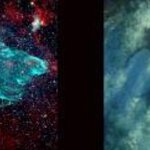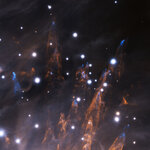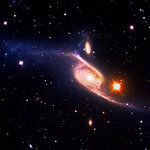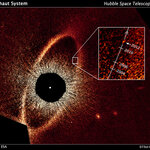Space
No, it is NOT a star! Several orders of magnitudes far from being a star actually. I am talking about quasars (quasi-stellar radio source) - often being described as distant stars. Oh, astronomers pain.
Quasars are absolutely fascinating. Little understood yet being used in our daily lives. Yes, you read me correctly. Since quasars are so far away and only move ever so slightly on the sky, we can use them as fixing points for our reference frame. The reference frame is the coordinate system we define all positions in and is one of the geodetic products. You might have heard about VLBI - Very…

A new view of 20,000-year old supernova remnant W50 provides more clues to the history of this giant cloud that resembles a beloved endangered species, the Florida Manatee. W50 is nearly 700 light years across, so it covers two degrees on the sky - the span of four full Moons
The W50 cloud formed when a giant star, 18,000 light years away in the constellation of Aquila, exploded as a supernova around twenty thousand years ago, sending its outer gases flying outward in an expanding bubble. The remaining, gravitationally-crushed relic of that giant star, most likely a black hole, feeds…

Most moons look ancient because their faces are pockmarked by thousands of craters but Titan, Saturn's largest moon, gets constant retouching because its craters are getting erased. Dunes of exotic, hydrocarbon sand are slowly but steadily filling in its craters, according to new research.
Titan is the only moon in the solar system with a thick atmosphere, and the only world besides Earth known to have lakes and seas on its surface. However, with a frigid surface temperature of around minus 290 degrees Fahrenheit (94 kelvins), the rain that falls from Titan's skies is not water but instead…

I experienced the highest density of colleagues with background from astrophysics when I worked at the Norwegian Mapping Authority. Mapping seems like an earthly matter, per definition, but it never was and never will be. First of all our planet Earth is exactly that - a planet! So I say as an astrophysicist I do not discriminate against any of the planets, including planet Earth! Right now I focus almost entirely on this particular planet.
The reason why I found myself surrounded by astrophysicist at the Norwegian Mapping Authority was GPS. Calculating the orbits of those GPS satellites…

Astronomers using using the Green Bank Telescope (GBT) in West Virginia, the Arecibo Telescope in Puerto Rico, and data from NASA's Spitzer and WISE (Widefield Infrared Survey Explorer) satellites have discovered hundreds of previously-unknown sites of massive star formation in the Milky Way, including the most distant such objects yet found in our home Galaxy.
The scientists found regions where massive young stars or clusters of such stars are forming. These regions, which astronomers call HII (H-two) regions, serve as markers of the Galaxy's structure, including its spiral arms and…

Astronomers have used the Spitzer and Hubble space telescopes to simultaneously to peer into the stormy atmosphere of the brown dwarf called 2MASSJ22282889-431026, creating the most detailed "weather map" yet for this class of strange, not-quite-star-and-not-quite-planet objects. The forecast shows wind-driven, planet-sized clouds enshrouding these strange worlds - forever.
They found that its light varied in time, brightening and dimming as the body rotated around every 1.4 hours, and also that the timing of the brightening changed depending on whether they looked at it with Spitzer or…

The barred spiral galaxy NGC 6872 has been considered a candidate for the biggest stellar system for decades and now a team of astronomers has officially crowned it the largest - so far.
Measuring tip-to-tip across its two giant spiral arms, NGC 6872 spans more than 522,000 light-years, making it more than five times the size of our Milky Way galaxy. The galaxy's unusual size and appearance stem from its interaction with a much smaller disk galaxy named IC 4970, which has only about one-fifth the mass of NGC 6872. The odd couple is located 212 million light-years from Earth in the southern…

There's a mystery in them there clouds - but astronomers at Caltech are on the case.
Near the crowded galactic center, billowing clouds of gas and dust hide a supermassive black hole 3,000,000X as massive as our sun, Its gravity is strong enough to grip stars that are whipping around it at thousands of kilometers per second. One particular cloud named G0.253+0.016
has delighted astronomers. Because scientists love a mystery.
G0.253+0.016 defies the rules of star formation. But apparently those are more guidelines than rules.
In infrared images of the galactic center, the cloud, which is…

Vega is the second brightest star in northern night skies and astronomers using the Infrared Space Telescopes have discovered an asteroid belt much like that of our sun.
Results showing an asteroid belt around Vega makes it more similar to its twin, the star called Fomalhaut. Both stars now are known to have inner, warm asteroid belts and outer, comet-filled belts, similar in architecture to the asteroid and Kuiper belts in our own solar system.
The Spitzer and Herschel telescopes detected infrared light emitted by warm and cold dust in discrete regions around Vega and Fomalhaut,…

The debris disk around nearby star Fomalhaut and a mysterious planet may be clues to a titanic planetary disruption in the system.
The debris belt is wider than previously believed, spanning a section of space from 14 to 20 billion miles from the star. And it seems the planet follows an unusual elliptical orbit that carries it on a potentially destructive path through the vast dust ring. The planet, Fomalhaut b, swings as close to its star as 4.6 billion miles, and the outermost point of its orbit is 27 billion miles away from the star, according to recalculations made from newer Hubble…